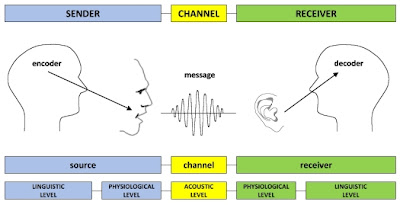From semiotics we moved on to the three branches of the study of signs namely syntax, semantics and pragmatics. This week, I will explain why pragmatics is an important consideration when examining visual communication.
Pragmatics in essence is the relation of signs to the users and interpreters and it is significant in visual communication because it studies they ways in which pragmatics factors determined meaning (Cartson, 2002).
Pragmatic factors capable of influencing and altering the meaning of the signifier and sign are codes, modality, sender, receiver, and context.
In semiotic theory, what keeps the patterns of meaning together is a code. It is an agreed upon set of rules by culture and society that guide the meaning making (O'Sullivan, 1994). We have many codes such as dress codes, linguistic codes of conducts which made up of the different elements we use to communicate with others. It further determine the dominant reading of the sign. For example, in Western culture, black is generally associated with death. It is agreed in western society that wearing black is considered traditional for funeral in their cultures. Meanwhile white in Western culture symbolized purity and it is the traditional color of bridal dress in the culture. However in contrast to that, the East Asia culture considers white the traditional color of mourning and wore white clothes in Chinese funerals. Therefore if the receiver's code of interpretation differs from the sender's code of communication, misinterpretation follows.
 |
| Supermodels Naomi Campbell and Kate Moss were entirely dressed in black for Alexander McQueen's funeral service |
 | |||
| The Kadarshian sisters dressed all in white for Kim's wedding. |
 | ||||
| However Chinese wear white at funerals |
The next factor is the modality which refers to the representation format in which the information is stored. Media theorist, Marshall McLuhan who coined the phrase “The medium is the message” asserts that exactly the same message will be interpreted differently by listeners, depending on the medium used to convey it
(Durham & Kellner, 2006). The pictures below show the front cover of different magazines paying special tribute to the late Michael Jackson. Although these magazines dedicate the issue to commemorate the King of Pop, but each magazines have different area of interests which affects how the message is being conveyed. So, by using a particular medium, the content and message can be successfully achieved and delivered.
(Durham & Kellner, 2006). The pictures below show the front cover of different magazines paying special tribute to the late Michael Jackson. Although these magazines dedicate the issue to commemorate the King of Pop, but each magazines have different area of interests which affects how the message is being conveyed. So, by using a particular medium, the content and message can be successfully achieved and delivered.
What message the sender encodes further determine the meaning and idea that is communicated. The message is received and decoded by the receiver. The receiver than develop meaning from the message according to their own ideals and views. However some encoded meanings may be decoded to mean something else which may lead to miscommunication as receiver interpret something very different from what the sender intended.
The final factor is context, which decides the meaning of the message depending on time and setting. Therefore meanings can change upon the context in which it takes place. Take for instance the word 'hell'. The example below illustrates how the meaning of the word changes in different contexts.
A boy screams 'hell yeah' after passing his exams.
A boy says “go to hell” when he gets mad.
A boy laughing with tears says, 'the joke is funny as hell'.
A boy pointing to an unidentified object says, “What in the hell is that?”
Therefore pragmatics plays a very significant role in understanding and interpreting the meaning of texts in visual communication.
References :
Cartson, R. (2002). Thoughts and utterances:The pragmatics of explicit communication. Germany:Blackwell Publishing.
Durham, M. G., & Kellner, D. (2006). Media and cultural studies:Keyworks. UK:John Wiley & Sons.
References :
Cartson, R. (2002). Thoughts and utterances:The pragmatics of explicit communication. Germany:Blackwell Publishing.
Durham, M. G., & Kellner, D. (2006). Media and cultural studies:Keyworks. UK:John Wiley & Sons.
O'Sullivan, T. (1994). Key concepts in communication and cultural studies. London:Routledge.





0 ulasan:
Catat Ulasan